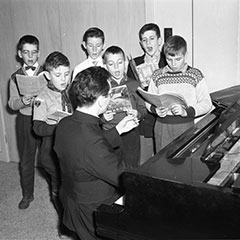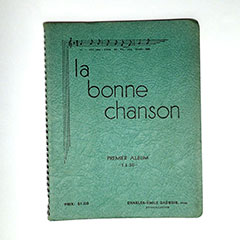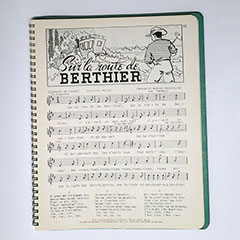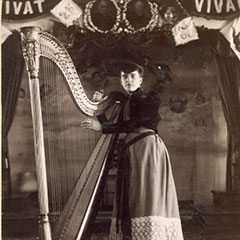Music in School
In 1931, Québec’s Department of Public Instruction began supporting singing and music in schools by publishing Le chansonnier canadien ( The Canadian Songbook ) by Uldéric Allaire. The book, which included 180 songs, contained the best melodies of the country’s traditional repertoire. In those days, students were taught songs that highlighted our past, patriotism and good morals.
La Bonne Chanson
This tendency is well illustrated by the Bonne chanson (The good song) collection, assembled by reverend Charles-Émile Gadbois. He felt Québec’s youth lacked musical knowledge. In 1937, he began printing sheet music for the students of the St. Hyacinthe College where he taught. His initiative was so successful that, a few months later, all the province’s schools, as well as many Francophone institutions of learning in Canada and the northeast United-States had heard about La Bonne Chanson . Most songs it included conveyed a heavily moral content, insisting on values such as family, homeland and nature.
In 1948, Québec’s Council of Public Instruction added singing to the official teaching program. As a result, two new albums were published, under the name La Bonne chanson à l’école ( The good song at schoo l). These educational albums spanned seven grades, each containing seventeen songs and five hymns.
Music in Schools Today
Today, the musical content presented to students is much more varied. The approach is also very different. In its music program, the Department of Education, Recreation and Sports seeks to develop artistic sensitivity and creative potential in young people. It encourages students to invent their own musical or vocal pieces; further, they are taught to interpret existing musical pieces, and they are trained to use critical thinking to appreciate musical works. In this context, students must learn some facts related to musical language, instrumental techniques and structural elements.
Marianne s’en va-t-au moulin (Marianne goes to the mill)
Download video: MP4 , (41,04 MB ), WebM , (42,09 MB ), Ogg (40,06 MB ) (3 minutes 26 seconds)
A group of kindergarten children sing Marianne s'en va-t-au moulin in their classroom with their teacher.
Mrs. Caroline Ricard’s kindergarten class at Jacques-Buteux School
Marianne goes to the mill
That is to grind her grain
That is to grind her grain
Riding her donkey, my little lady
Marianne
Riding her donkey
Dolly going to the mill.
The miller, who sees her coming
The miller, who sees her coming
Immediately hastens to tell her
Immediately hastens to tell her
So fasten your donkey, my little lady
Marianne
So fasten your donkey
Dolly, behind the mill
While the mill worked
While the mill worked
The wolf prowled around
The wolf prowled around
The wolf ate the donkey, little lady,
Marianne
The wolf ate the donkey
Dolly, behind the mill.
Marianne began to cry
Marianne began to cry
A hundred golden crowns he gave her
A hundred golden crowns he gave her
To buy a donkey, little lady
Marianne
To buy a donkey
Dolly, behind the mill
Kindergarten
Download video: MP4 , (23,09 MB ), WebM , (23,18 MB ), Ogg (23,44 MB ) (1 minute 33 seconds)
Video explaining what a kindergarten class is like in Québec. The video clip shows children dancing in a circle while singing and painting under the supervision of a teacher.
Source: Bibliothèque et Archives nationales du Québec, Québec Archives Centre, Fonds Ministère de l’Éducation, du Loisir et du Sport (Ministry of Education, Recreation and Sports Funds), E13, S77, DFC
TEXT: The Communication Services of the Ministry of Education presents:
KINDERGARTEN
Children singing:
"Food stock began to wane.
Food stock began to wane.
Ahoy! Ahoy!
Straws were drawn all around
Straws were drawn all around
To figure out who'd be eaten,
To figure out who'd be eaten.
Ahoy! Ahoy!"






